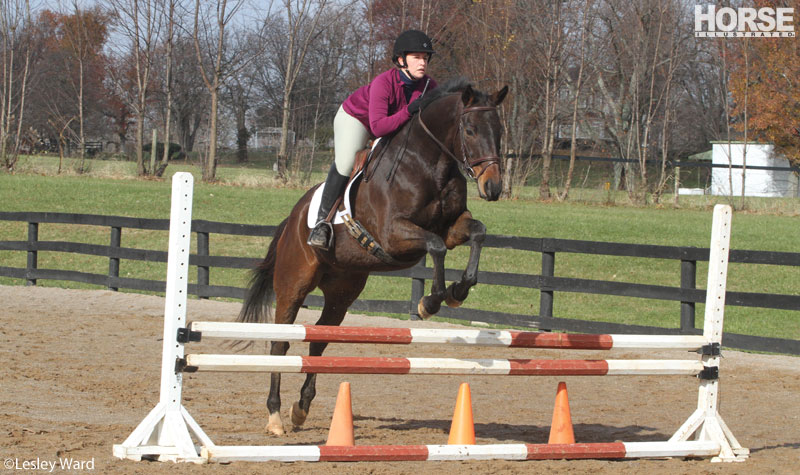
Fortunately, such scenarios are rare. A horse that’s been properly schooled and is piloted by a rider with a solid foundation should willingly do his job and jump what’s in front of him.
If your jumping lessons and competition rounds are consistently peppered with refusals and run-outs, then perhaps it’s time for some self-reflection. Without realizing it, you could be contributing to the problem. Here are some of the most common mistakes riders make, along with tips to overcome them.
1. Jumping Ahead of Your Horse
In the final moments before the horse leaves the ground, the rider demonstrates a sudden change in her position. Typically she pops upward in the saddle, leans onto the horse’s neck, or rolls her shoulders forward.
This is often a compulsive habit due to the rider’s anxiety. These overeager types will thrust their bodies at the jump in a misguided effort to help the horse leave the ground.
As the rider tips forward, she shifts her weight onto her horse’s front end just as he’s trying to rock back onto his hocks to jump.
This sudden movement in the saddle disrupts the horse’s concentration. Once he becomes distracted and unbalanced, it makes a refusal or run-out an attractive option.
Fixing the Problem: If you are guilty of jumping ahead, work closely with a qualified instructor who can remind you to hold your two-point or half-seat position all the way to the jump. You can also use a stationary focal point (such as a cone, fence post or tree) that’s aligned with a straight approach to the jump. This will distract you from anticipating the jump and force you to wait for your horse to leave the ground before inclining your body forward.
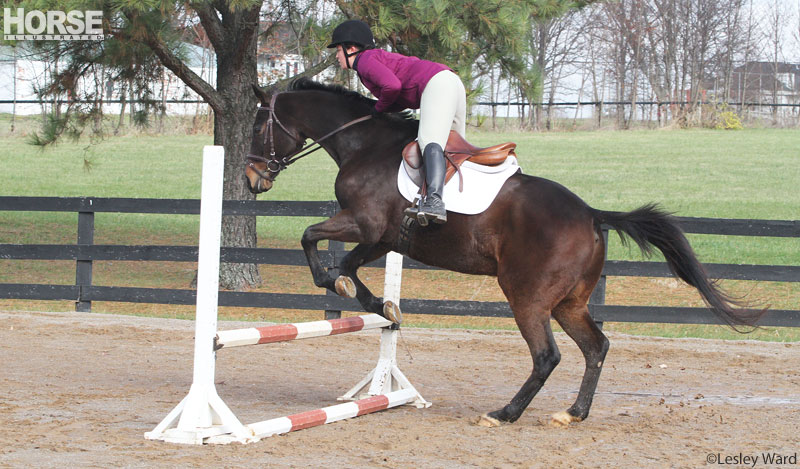
Here, Kelly demonstrates jumping ahead, one of the most common causes of refusals.
2. Abandoning Your Horse at the Base of the Jump
Although the rider maintains a steady, robust rhythm on the approach, once her horse arrives at the jump, her driving aids shut down. Where the horse was previously encouraged to continue forward, he’s now left on autopilot. His rider has assumed the role of a passenger.
Usually perceived as the sign of a weak or indecisive rider, this bad habit is commonly referred to as “wilting at the base of the jump.”
When viewed from behind, it may be apparent that the rider’s lower leg has been pulled away from the horse’s side. She might also hunker down in the saddle in a defensive position.
Though many riders don’t express it, this fault can be due to unacknowledged fear and warrants a candid conversation with their instructors.
Not every horse needs to be urged forward with leg pressure in order to jump, but no horse appreciates being abandoned by his rider at the last moment. This estrangement invites a refusal or run-out.
Fixing the Problem: Place a ground pole about 46 feet away from the landing side of a low vertical jump. Approach the jump in a working canter. You’ll have to use your leg aids throughout the approach to the moment of takeoff, and as necessary when your horse lands, in order for him to comfortably canter over the ground pole in three strides. Making a commitment to get to the ground pole in three strides will also force you to envision riding “through” the jump, rather than merely up to the base of it.
3. Asking Too Much of Your Horse
Young, talented horses are sometimes rushed through their training. As a result, they’re unprepared for today’s technically challenging courses. At the other end of the age spectrum, saintly senior equines can become sore and fatigued when asked to jump beyond their physical capabilities.
A green horse that becomes fast and more animated when he jumps is exhibiting anxiety, not bravado.
Green horses, by definition, lack jumping experience. If pushed too far too fast, they’ll begin to make mistakes like hitting rails, which stings. This undermines the greenie’s confidence, which will soon lead to refusals or run-outs.
The average teenaged jumping horse might have some level of age-related arthritis. To preserve his soundness and joint health, he may need to be placed on a vet-supervised regimen.
A previously reliable older horse that begins refusing or running out is probably hurting somewhere. He may need a soundness evaluation and/or the jumps lowered.
Fixing the Problem: Training and lesson programs should be tailored to each individual horse’s needs. For example, greenies must learn to use their bodies properly as they go through the motion of jumping. That’s why trotting cavalletti and small, low jumps is so important. Older horses benefit from these basic exercises, too, since they put minimal stress on joints yet help maintain flexibility and condition.
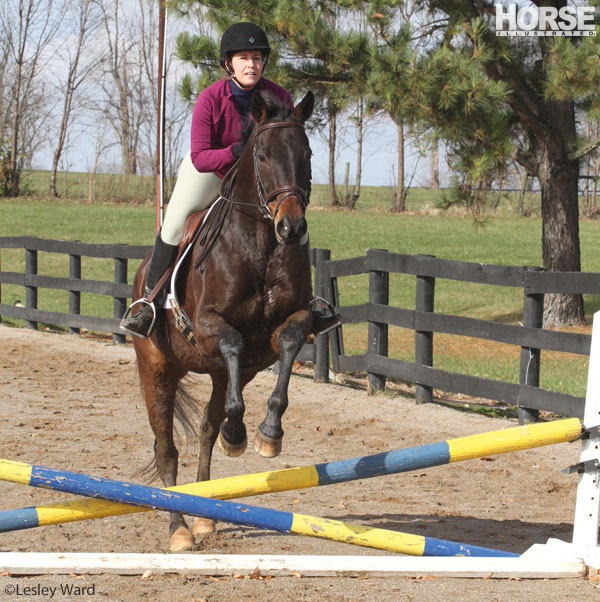
Trotting small cross-rails will put less wear and tear on an older horse and keep green horses from being overfaced.
4. Riding Your Horse to an Impossible Takeoff Spot
Who can blame a horse for refusing or running out when the alternative seems suicidal? Riders who bury their horse at the base of an oxer, or unwittingly steer their horse toward the standards, shouldn’t be surprised if he stops or runs out.
Fixing the Problem: If you invariably ask your horse to jump from awkward takeoff spots, there’s a simple yet rather revealing exercise you can use. Draw a line about 3 feet from the center of a low, simple jump in the dirt of the arena; this represents a safe takeoff spot. (Using spray paint will make it more visible.) You must canter the jump, but use your aids to guide your horse and adjust his pace and length of stride so that he steps inside that line at takeoff.
Liked this article? Here are others you’ll enjoy:
Stop Jumping Refusals
Teach Your Horse to Jump in 5 Simple Steps
Special thanks to Kelly Rover and her off-track Thoroughbred, Wilder Than Syn, for demonstrating these exercises, photographed at Masterson Station Park (www.mastersonequestrian.org)
in Lexington, Ky.
During her lengthy show career on the hunter/jumper circuit, CINDY HALE won more than 20 medals for hunt seat equitation. She currently serves as a judge at local and regional open horse shows.
This article originally appeared in the February 2014 issue of Horse Illustrated magazine. Click here to subscribe!



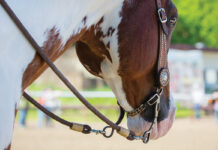
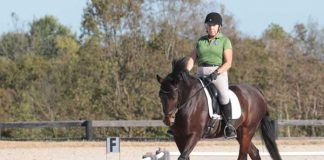

Oh, Thank You for all the good information. I do not have a instructor, and want to learn all I can about jumping, so I do not hinder my horse, while jumping. I am going to read the other links given.
I was good until you recommended that one draw a line in the sand to indicate a safe take off spot. NOT a good idea at all!
Who’s looking at that line?
If it’s the rider, I can tell you exactly why the horse stops the next time. If it’s the horse, I can answer that one, too!
The biggest problem with riders and jumping is that they ride when jumping differently than they hack the horse. Who was ever going to explain that to the horse?
Ride a completely straight line at the right, reasonable, responsible rhythm for the obstacle and quit trying to pick the distance and “get ready”.
Simple. Training it is the hard part.